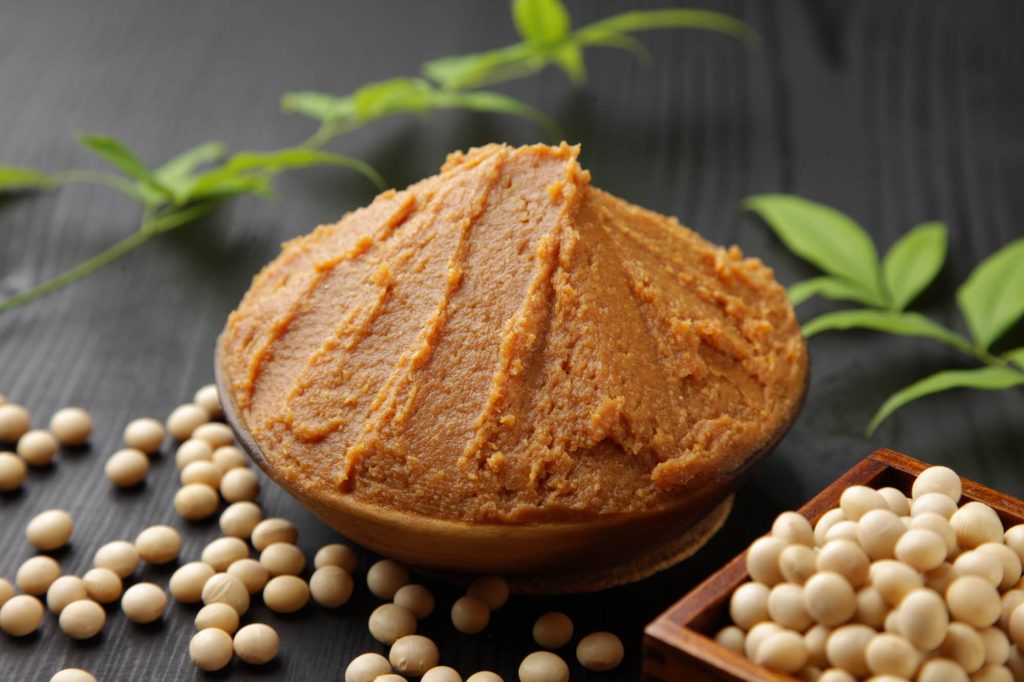
A traditional Japanese bean based fermented food is becoming popular worldwide. It possess a salty taste with a texture similar to nut butter, though the specifics vary depending upon the ingredients and length of fermentation. The mixture is aged from one month to three years.
The fermentation process breaks down the complex and sometimes hard to digest oils, proteins and carbohydrates found in soybeansinto forms more easy for the human body to digest. In addition, the final product (assuming it is unpasteurized) contains live lactobacilli, which also enhance your body’s ability to extract nutrients from food.
The popular varieties of miso include hatcho (made with soy only), genmai (made with soy and brown rice), kome (made soy and white rice), mugi (made with soy and barley), natto (made with soy and ginger) and soba (made with soy and buckwheat).
Why a Super Food?
The nutritional composition of the food is added on by fermentation are enough to categorize miso as a super-food. The nutrients found in miso- vitamin B2, vitamin E, vitamin K, calcium, iron, potassium, choline and lecithin. Miso is also high in dietary fiber and provides a large amount of complete protein. It is especially high in polyunsaturated fats, which the FDA has endorsed for their ability to lower the body’s levels of LDL (“bad”) cholesterol. One of these facts, linoleic acid, actually helps keep skin soft and young-looking.
Miso (100 grams)
Composition and Nutrient Content
|
|
(Source unless specified: Composition of Foods: Legume & Legume Products. USDA, Human Nutrition Information Service Agriculture Handbook No. 8-16 http://www.soyfoods.com)
- A complete Protein: miso, which is made from fermented soybeans, is high in complete proteins that contain all essential amino acids and should be considered an important source of protein for herbivores and carnivores alike.
- Antioxidant: miso is now known to contain phyto-nutrient antioxidants including phenolic acids like ferulic, coumaric, syringic, vanillic, and kojic acid. Besides, the amount of some specific antioxidants in miso appears to increase when fermentation is carried out for a longer period of time. DDPH (2,2,-diphenyl-1-picrylhydrazyl) antioxidants appear to be one category of miso antioxidants that increases with prolonged fermentation.
- Excellent Mineral Source: Soy miso is a very good source of manganeseand a good source of zinc (both important mineral antioxidants). It is also a very good source of the minerals, iron, calcium, phosphorus and copper.
- A “pre-digested.” Food: Aspergillus and other micro-organisms used in fermentation of soy miso help metabolize proteins, carbohydrates, andfats found in soybeans and transform them into smaller molecules that can be digested easily. In addition, depending on processing and fermentation methods, some soy miso can contain “friendly” bacteria like lactic acid bacteria (including various species of Lactobacillus) that might be helpful in supporting intestinal microflora. It helps promote a healthy pH in the digestive system. Another micro-organisms – including bacteria, Bacillus subtilis is used in fermentation of Chinese miso than in Japanese, Korean, or Indonesian versions. This micro organism has the ability to create a form of vitamin K called menaquinone-7 (MK-7), an important nutrient for bone health.
- Further, soybeans are about 20 percent oil and are an excellent source of quality polyunsaturated fats. This variety of fat is so beneficial that, FDA has recognized its ability to lower “bad” cholesterol and has authorized manufacturers of soy products to label them as able to reduce the risk of heart disease.
Miso soup, a traditional Japanese soup prepared from miso paste (soya beans paste) is great source of dietary fiber, minerals and protein. It contains amino acids,omega-3, omega-6 fatty acid and vitamin K in high amount. 275g of miso soup contain 32g of protein. Miso soup provides more than 12% protein. 3 bowls of miso soup is similar to 1 chicken fillet.
Ones to try: sweet white, mellow white, chickpea (safe for those with soy allergies), barley (mugi), and red.
Studies have shown that including soy in our diet may help protect against heart disease, cancer, and osteoporosis, and research continues to show other beneficial effects that soy consumption may offer to our general well-being. Overall, including soy foods in moderation and as a part of a balanced diet that includes fruits, vegetables, whole grains, and lean meats is a smart decision that can help you maintain a healthy body and prevent disease.
